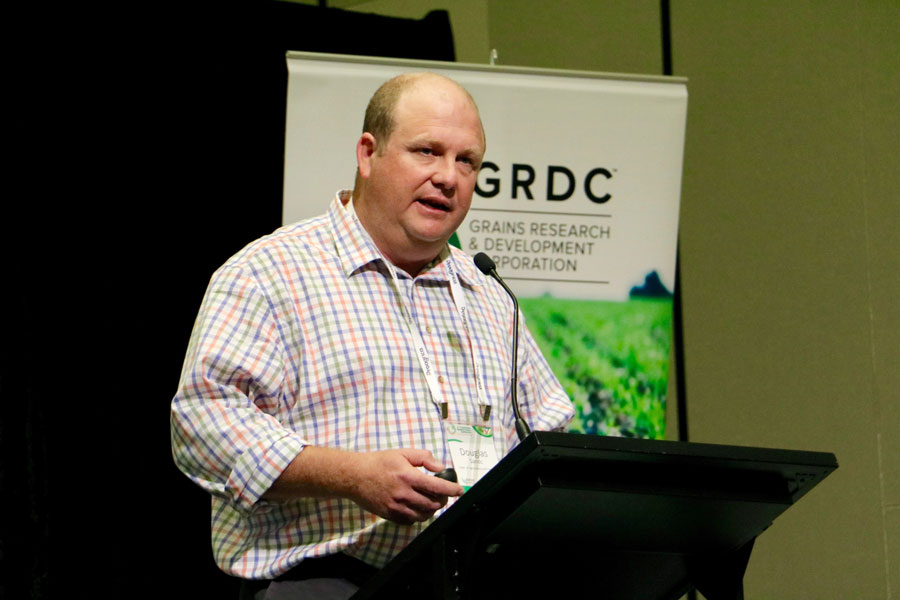Key points
- Mungbeans are a net soil nitrate consumer
- Pre-applied nitrogen fertiliser does not lead to better mungbean yields
- The crop uses a combination of both soil nitrates and fixed nitrogen to meet its needs
- Nitrogen fixed by the crop decreases as nitrate supply increases from applied nitrogen
- The results have implications for farming systems’ nutritional plans
Pre-applying nitrogen fertiliser to mungbean crops does not lead to better yields. Instead, research from Central Queensland is showing that mungbeans are a net soil nitrate consumer and any applied nitrogen fertiliser reduces the amount fixed from the atmosphere.
The results from two years of trials have implications for a farming system’s overall nutrition plans, says Emerald-based research agronomist Doug Sands. He says finding out that mungbeans take more nitrogen than they provide in cropping scenarios was a surprise.
Mr Sands’ Queensland Department of Agriculture and Fisheries trials, part of the GRDC-supported Mungbean Agronomy project, have examined what role added nitrogen fertiliser has in enhancing
mungbean production. Until recently, nitrogen has been somewhat overlooked in mungbean research because of the pulse’s known nitrogen-fixing properties.
“Traditionally, mungbean has been sown as a rotational cash crop. It has been thought to also contribute nitrogen to the farming system and help reduce reliance on both nitrogen fertiliser and mineralised nitrogen from organic sources,” Mr Sands says.
However, with good mungbean prices, researchers have been keen to explore whether nutrition can increase crop productivity. In 2020 and 2021 at the Central Queensland Smart Cropping Centre near Emerald, a series of trials tested grain yield responses to applied nitrogen at rates up to 150 kilograms per hectare.
Combined nutritional sources
Examining the yield data, the project team, including Jayne Gentry and Cameron Silburn, found that mungbean grain yields were generally not responsive to applied nitrogen.
Measuring nitrogen derived from atmosphere (Ndfa) showed that mungbeans have a lower nitrogen fixation efficacy relative to some other pulse species and their fixation efficiency is sensitive to soil nitrate meaning nitrogen fixation is reduced when soil nitrate levels increase. Total dry matter and harvest index also helped explain why the crop has a net negative nitrogen balance. Interestingly, mungbeans can use either source of nitrogen without affecting yield, as long as rhizobia bacteria are present.
Mr Sands says the most common factor found across all trials was that the amount of nitrogen fixed by the crop decreases as nitrate supply increases from applied nitrogen.

Queensland Department of Agriculture and Fisheries research agronomist Doug Sands. Photo: Rebecca Thyer
In most cases, fixed nitrogen reduces to less than 10 per cent once fertiliser application rates reach 60kg of nitrogen/ha or more.
The 2021 irrigated trial was the only exception. Grain yields exceeded two tonnes/ha and the Ndfa remained at 20 per cent for applications of 60kg of nitrogen/ha and 90kg/ha. “This may have been because the plant was feeding a larger biomass. Otherwise, there is a linear regression between increasing applied nitrogen and decreasing fixed nitrogen.”
Mr Sands says calculations using the nitrogen harvest index (NHI) and the Ndfa percentage shows the amount of fixed nitrogen being returned to the soil profile is quite small. Even in control treatments where fixation is at its highest, the maximum amount being contributed is 14kg of nitrogen/ha or less. In the dryland trials that number is closer to two to 4kg/ha.
The level of soil nitrates in the top 60 centimetres of the soil profile also considerably influences Ndfa and reflects where the crop’s root system is most active. Mr Sands says it shows that the more nitrate that is contained in the soil profile’s top 60cm, the more efficient the soil's nitrate uptake, which reduces the requirement for fixation.
Management considerations
Overall, the research shows that mungbeans’ ability to contribute fixed nitrogen to the soil profile is compromised by the amount of nitrogen mineralised during the fallow prior to planting. In most cases, it reduces soil nitrate levels available for the next crop.
“This creates greater pressure on the soil’s organic matter to continue to mineralise nitrates if non-organic fertiliser is not used to meet the deficit. Growers will need to compensate nitrogen fertiliser rates for the following crop to cover for the potential nitrogen deficit created by the mungbean crop.”
Mr Sands says it points to the need for a whole-system nutrition approach. “The incorporation of legumes in the system is making nitrogen supply less predictable. You are never really sure how much the legumes are putting in or taking out. That’s because it depends on species, water supply and levels of nitrogen mineralisation, which are usually dependent on fallow length.
“Not all legumes behave the same way as mungbeans. Faba beans fix more nitrogen, but chickpeas possibly fix less depending on environment. It really makes it important to track your nitrogen supply far more regularly.”
Mr Sands says mungbeans remain a high-value and important crop. “In a normal season, they generate a good gross margin, even if the value of nitrogen exported off the paddock is factored in.
“The other factor is that the crop can cover any nitrogen shortfall without risking yield as long as it has been inoculated, unlike a cereal crop. We just need to remember that, after harvesting, the amount of nitrogen left in the profile will probably be similar to that of a cereal crop.”
Mr Sands will be presenting the results at the winter GRDC Update series starting in July, individual Update programs will be finalised closer to the date.
More information: Doug Sands, douglas.sands@daf.qld.gov.au, GRDC Update series

























































